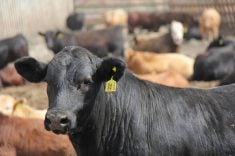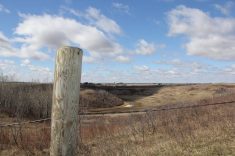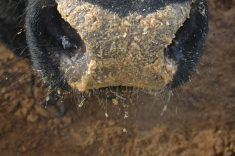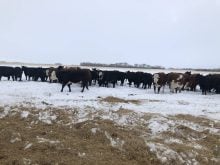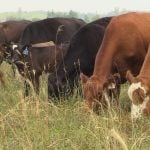Careful observation while in the calving barn and notes kept by producers during calving season becomes an important scorecard for improvement and a management tool for the
entire year.
As with most things in life, victory lies in planning, a successful calving season among them. Planning starts by understanding where risk resides in an operation then evolves with monitoring, measuring and synthesizing information. Good notes help.
For starters, by the time calving season rolls around there should be few surprises about the breeding performance of the bull battery. The start and end of calving season should match the start and end of a controlled breeding season. If the calving period stretches beyond two to three heat cycles, if there is an unexpected number of open cows or the distribution of calves born is erratic, bulls should be checked and common reproductive diseases like those caused by Campylobacter and Tritrichomonas ruled out. Even birth weights and calving difficulties should be negligible if homework from last year was completed.
Read Also

U.S beef industry faces demand risks and disease dangers
High beef prices and New World screwworm threaten beef demand and cattle health in the U.S.
Starting now, body condition scores (BCS) for the brood cow can be used to estimate nutritional requirements for the last trimester of pregnancy. Feeding adjustments can be made as necessary. To obtain optimum post-calving fertility, mature cows should calve with a body condition score of 2.5 to 3.0 and maintain it through the breeding season. Flushing, the practice of feeding a very high level of nutrition for a couple of weeks before the start of the breeding season, may help cows below optimum condition. Generally, flushing will not enhance post-calving reproduction in thin cows (BCS 1.5 or less), but the additional energy will improve the quantity of milk as they start nursing. Reduction in weaning weight is another adverse effect of inadequate cow nutrition. Reports indicate a five per cent to 25 per cent reduction in adjusted 205-day weaning weight of calves from dams with a body condition of less than 2.0 at calving or from nursing cows losing condition after calving.
The calving season scorecard will help assess whether or not assistance with calving cases was appropriate and if intervention was applied in a timely manner and handled using the right tools.
A number of environmental factors should be noted and monitored through calving season. Protecting the newborn calf from weather extremes becomes a critical consideration. The newborn possess a limited ability to regulate body temperature and are very susceptible to cold. The cold-stressed or hypothermic calf is not thrifty and its survival in cold, wet, muddy conditions can be severely compromised.
Traumatic injury remains high on the list of clinical syndromes observed by veterinarians in young calves. Crowded conditions increase the risk of calves being stepped on or crushed. Physical hazards like protruding nails, broken posts, loose wire, standing water and exposed electrical wires create danger zones for young calves. Barns are a common storage site for partially used containers of toxic pesticides or carelessly discarded batteries, a frequent source of lead poisoning for the inquisitive calf. Calving grounds should be examined for potential hazards every year prior to calving season.
Minimizing the risk of infectious disease in the young calf is still the biggest challenge for most cow-calf producers. While non-infectious problems cause most of the losses in the first two to three days, things like dystocia, hypothermia and hypoglycemia (low blood sugar) increase the risk of calf death from infectious disease five-to eightfold. Management practices aimed at identifying and resolving early problems are the single most direct and cost-effective way to improve calf health. Within a few minutes after leaving the uterus the baby calf must breathe properly, void waste, generate heat and maintain body temperature, stand, and seek food. Calves should be evaluated frequently during the first several hours after being born. Most calves will be on their feet within the first hour. Signs that the adaptive process is not progressing normally are subtle: inactivity, weakness, slowness in normal behaviour (standing, suckling), low body temperature, and low or erratic heart and respiratory rates. Affected calves may look fairly normal for 15 to 30 minutes after delivery, then gradually become weaker and less responsive. Lack of vigour and unresponsiveness are cardinal signs of problems.
Most calf deaths are caused by infectious disease like scours, generalized infections (septicemia) and pneumonia. The first and most important barrier to disease is ensuring the new calf receives colostrum within the first few hours of birth. Ideally, the calf should consume five per cent of its birth weight in colostrum (two litres) within the first 12 hours. Calves that have failed to nurse within three hours should be given colostrum by esophageal feeder.
Acquired infections after birth are primarily a numbers game. Even the strongest, most vigorous calf can succumb to infections in a crowded, dirty calving environment where the numbers of pathogens can overwhelm any level of immunity a new calf may muster. The adult cow is most often the unwitting donor of pathogens for her own and other calves. The numbers of pathogens like scour-causingE. coli,cryptosporidia, coccidia and rota and corona viruses grow quickly in crowded, damp conditions, then explode when sick calves start shedding billions more infectious particles. The inventory of “bad bugs” steadily increases during the span of a calving season unless care is taken to create space and clean ground.
Diagnostic information gleaned from sick calves plus information about the events of each calving season provided from records kept by producers are essential to designing effective biosecurity and disease control programs. The scorecard is an important part of managing risk.
Dr.RonClarkepreparesthiscolumnonbehalfoftheWesternCanadianAssociationofBovinePractitioners.SuggestionsforfuturearticlescanbesenttoCANADIANCATTLEMEN( [email protected]) orWCABP( [email protected]).




